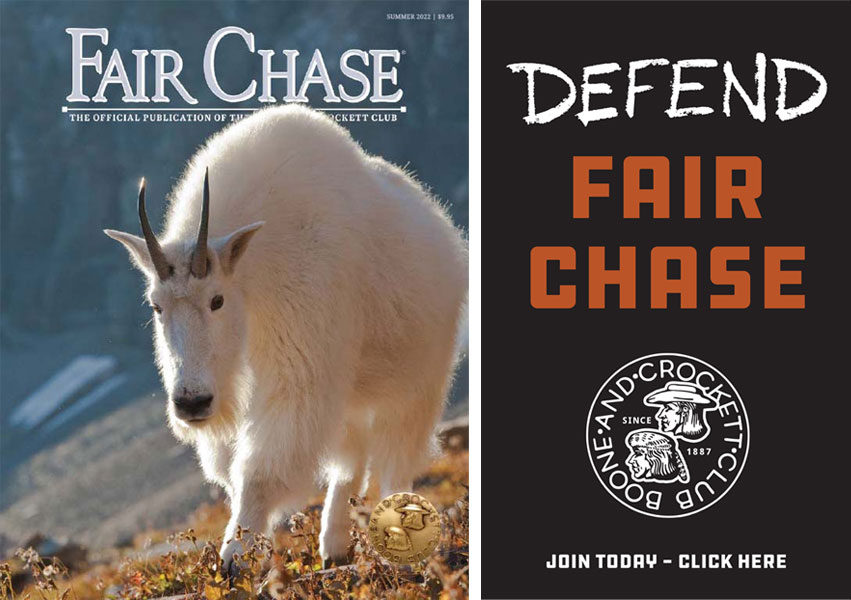Wild-Harvested Meat's Role in Public Support for Hunting and Conservation
SCIENCE BLASTS
By John F. Organ, B&C Professional MemberExcerpt from Fall 2015 issue of Fair Chase
Aldo Leopold wrote “One of the anomalies of modern ecology is the creation of two groups, each of which seems barely aware of the existence of the other. The one studies the human community, almost as if it was a separate entity, and calls its findings sociology, economics, and history. The other studies the plant and animal community and comfortably relegates the hodge-podge of politics to the liberal arts. The inevitable fusion of these two lines of thought will perhaps constitute the outstanding advance of this century.” Leopold, of course, wrote this during the last century, and his vision was not fully realized. Among those who are ensuring Leopold’s vision is realized this century are my colleagues, Professor Shawn Riley and graduate student Amber Goguen of Michigan State University, working in an area of study known as human dimensions of wildlife management.
Shawn cut his teeth as a wildlife biologist with Montana Fish, Wildlife & Parks and went on to earn a Ph.D. at Cornell as part of the New York Cooperative Fish and Wildlife Research Unit and the Human Dimensions Research Unit. With his pedigree, he is uniquely qualified to fuse wildlife science and the social sciences. Shawn’s interests resulted in a Fulbright scholarship to study the game management culture in Sweden. One major difference between hunting laws in North America and those in Sweden is that in Sweden hunters are allowed to sell wild-harvested meat from animals they have legally harvested. Shawn and his Swedish colleagues studied the differences in attitudes towards hunting and conservation of urban non-hunting Swedes who had access to wild-harvested meat and those who did not. Those who had enjoyed wild-harvested meat expressed more positive attitudes toward hunters and greater acceptance of hunting.
Those who had enjoyed wild-harvested meat expressed more positive attitudes toward hunters and greater acceptance of hunting.
Shawn and colleagues at the Michigan Department of Natural Resources are interested in exploring how access to venison by Michigan residents might affect attitudes towards hunting. Initially, they sought to answer the question: How much access do Michigan non- hunters have to venison given that it is illegal to sell wild- harvested meat in the United States? Amber Goguen recently completed her Master of Science degree with Shawn, examining this relationship, and has moved on to a Ph.D. study comparing the distribution and effects of wild-harvested meat in Sweden and Michigan.
Amber’s work to date has shown that despite the lack of a market for wild-harvested meat, venison sharing is common in Michigan and a surprising percentage of non-hunters consume wild-harvested meat on a regular basis. The chief impediment to accessing wild venison appears to be whether a non-hunter knows a hunter. Amber is now exploring the specific social pathways that predispose sharing opportunities and the impact that access by non-hunters has on public attitudes and behavior toward hunting and hunters. Her analyses should provide policy makers and hunters with insights on actions they can take to enhance opportunities for non-hunters to access wild-harvested venison.
In recent years, conservation leaders have bemoaned the growing disconnect between people and nature in North America. Similar concerns over rapid urbanization and a distancing from the outdoor life were in the forefront of discussions that Theodore Roosevelt and George Bird Grinnell had that led to the creation of the Boone and Crockett Club. The significance of Amber and Shawn’s work is that it may foster strategies that hunters can play in coupling people and nature, garnering popular support of our hunting heritage. Can we capitalize on the locavore movement to promote wild-harvested meat as healthy, local, and environmentally friendly? Will urbanites and suburbanites who view locally overabundant whitetail deer as pests and liabilities develop a new appreciation for this resource? Will the role of hunters as a source for healthy local meat generate increased appreciation for them? Could the realization that a person can provide themselves with high-quality, healthy meat without owning a ranch motivate non-hunters to buy a license and go afield? Could this contribute to efforts to recruit hunters?
These questions and others will have key policy implications as the Club and others work to ensure our hunting heritage is secure for future generations by maintaining relevance to our cur- rent generation. Stay tuned for a future feature-article by Amber and Shawn with results of their efforts.
Click here to learn more about B&C's cookbook, Wild Gourmet.
More Science Blasts
Read more articles about conservation, hunting, and wildlife research by John Organ, Director Emeritus of the USGS Cooperative Fish and Wildlife Research Units, and current B&C professional member.
Interested in More?
Image

|
